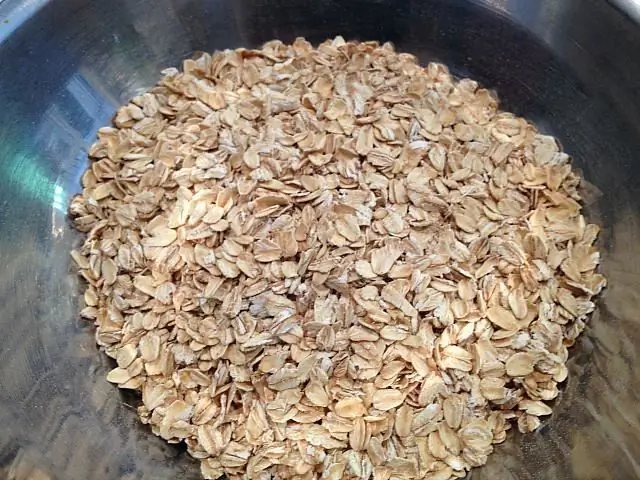2026 Author: Isabella Gilson | [email protected]. Last modified: 2025-01-23 12:50:36
Grains occupy one of the main parts of the diet of proper human nutrition. Cereals from them are most often included in breakfast, as cereals are rich in complex carbohydrates and nutrients. Porridge cooked for breakfast will give you satiety and provide energy for the next day, while low-calorie cereals will take care of your figure.
Benefits of cereals

Grains are rich in B vitamins. Since B vitamins are the fastest absorbed by the body, you need to replenish their supply daily. They have a beneficial effect on the digestive and cardiovascular systems, improve the condition of the skin and hair. Also, B vitamins contribute to raising efficiency, improving memory, and normalizing sleep. During a period of depression or stress, as well as a high workload, it is especially important to provide yourself with B vitamins.
Grains contain slow carbohydrates that take longer to digest in the human body than simple ones. Due to this feeling of hungercomes later. Often cereals are added to the diet. Since the body spends additional calories on their digestion, and useful substances ensure the well-being of the whole organism. Diets that exclude the content of complex carbohydrates introduce the body into a state of stress. Despite the rapid weight loss, the extra pounds will return as soon as you stop dieting.
Grains also contain potassium, magnesium, calcium, iron, he althy fats and other trace elements.
Dry cereals calories

A wide variety of types of cereals allows you to choose the product you like the most. Despite the difference in tastes, all cereals are united by high calorie content. The calorie content of dry cereals varies from 300 to 350 Kcal (product weight 100 grams).
The table below shows some cereals and their dry calorie content.
| The name of the cereal | Calorie per 100 grams |
| Rice | 330 |
| Buckwheat | 335 |
| Semolina | 328 |
| Barley | 320 |
| Oatmeal | 342 |
Calories in cooked cereals

The energy value of cooked porridge is significantly different from the energy value of a dry product. During the periodcooking cereal absorbs water and becomes larger. It can increase two, three or five times. The more water you add to your porridge, the fewer calories it will contain.
To determine the calorie content of cooked porridge, you need to add the calorie content of additives and spices (if any) to the calorie content of the dry product and divide by the weight of the finished dish.
Calorie content of ready-made cereals you can see in the table below.
| The name of the cereal | Calorie per 100 grams |
| Rice rice | 113 |
| Buckwheat | 163 |
| Semolina | 98 |
| Barley | 106 |
| Oatmeal | 88 |
According to the second table, we can conclude that the calorie content of boiled cereals is several times less than the calorie content of dry cereals.
Tips for cooking diet cereals

When buying cereals, pay attention to its cleaning and grain processing. Whole grains have fiber, which helps to normalize metabolism and cleanse the body.
If you want to cook diet porridge, then you should pay attention to the products that you add to the dish. To keep cereals low in calories, boil porridge in water instead of milk. Refuse to add oil, sugar, dried fruits and othersweeteners.
To save time, you can leave the well-washed cereal in a bowl of water overnight. During this time, the cereal will absorb water. Only after, i.e. when the porridge is completely dry, it can be eaten.
Add fresh fruit or sweetener to an already prepared dish. For an optimal diet, 100 grams of a dish will be enough at one time. This porridge is perfect for both breakfast and a small snack.
Recommended:
The lowest calorie cereals. List of cereals. low calorie dinner

During the diet, the lowest-calorie cereals are of great importance, since they are able to fill the body with the missing vitamins. There are many varieties of cereals that are allowed to be consumed with diets, but not all of them can help in burning fat. Indeed, in this matter it all depends on the calorie content of the product, therefore, before compiling a diet, you need to look at the best low-calorie cereals for weight loss, indicating the calories provided in the article
Semi-finished products from fish: types and composition. Storage of semi-finished fish products

Semi-finished fish products are very popular among housewives who want to save a little time on cooking. Today we’ll talk about what semi-finished fish products are, how they differ, how fish is processed before production, and how to properly store such food
Semi-finished product is Frozen semi-finished products

Today, a semi-finished product is a very popular product among housewives due to the fact that it is prepared quite quickly and easily
"Hercules": calorie content in water and milk. What determines the calorie content of the finished dish?

Oatmeal is indispensable when you need to quickly prepare a he althy and tasty breakfast for the whole family. From this article you will learn what nutritional value "Hercules" has, its calorie content and useful properties
Semi-finished products "Ermolinsky": reviews, prices. "Yermolinsky semi-finished products": where is the production?

The company has its own chain of stores. Residents of more than 500 cities in Ukraine and Russia fell in love with "Yermolinsky semi-finished products". Where the production is located is still a mystery for many. The fact is that the official website of the company is still under development and information about the actual address of the production has not been made publicly available. And on the packaging of goods the legal address is indicated: Russia, Kaluga region, Borovsky district, Ermolino, st. Zarechnaya, 5 (hence the name)

